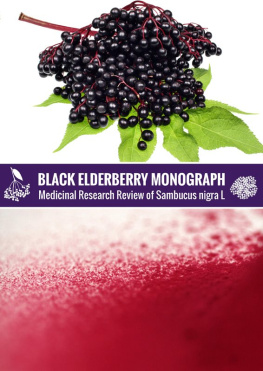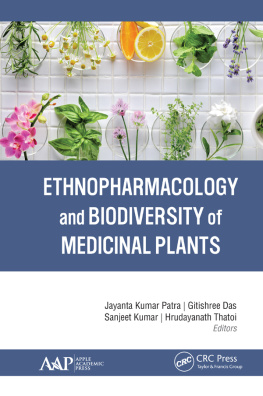Copyright 2016. All rights reserved.
Berry Pharma Extracts, Iprona AG, Lana, Bolzano, Italy.
www.iprona.com
Disclaimer: This publication is not intendedas a substitute for the medical advice of physicians. The reader should regularly consult a physician in matters relating to his/her health and particularly with respect to any symptoms that may require diagnosis or medical attention.
ISBN: 978-1-4835855-3-6
Contents
Introduction
This monograph provides a detailed review of published literature on the subject of black elderberries in traditional ethnomedicine and modern healthcare. The content was compiled for use by professionals who require detailed information for product development and regulatory evaluation of black elderberries. Research and writing was conducted by Kenneth Jones, a creative science writer and consultant specializing in food and medicinal plants for over 25 years, and a member of the Advisory Board of the American Botanical Council since 2005.
Black Elderberry Monograph was commissioned by BerryPharma Extracts, a business unit of Iprona AG, Lana, BZ the leading international supplier of membrane-enriched extracts of black elderberries.
Botanical Description
Scientific name:Sambucus nigra L.
Family: Adoxaceae; formerly Caprifoliaceae .
Synonym:Sambucus nigra subsp. nigra .
Common names: Black elder; European elder berry .
Native range: Europe, Georgia, Azerbaijan, Armenia, Turkey, Tunisia, Algeria, and southern Russia .
Habitat: Forest margins and open or cultivated grounds [reviewed in ref. 7].
European black elderberry (hereafter, black elderberry) is a deciduous, perennial shrub or tree growing up to 10 m in height with corky, deeply furrowed, brownish-grey bark. Usually with 57 leaflets, the leaves (20 cm in length) are opposite, pinnate, serrated, and of an unpleasant odor. The flowers are small (5 mm in diameter), fragrant, and creamy white. Displaying 5 primary petals, each flower has the appearance of a softly shaped star. Flat-topped clusters of the flowers (corymbs; 1020 m in diameter) give way to juicy, green, globular berries (68 mm in diameter) containing 35 seeds. In August and September, the berries become fully ripe, black .
History and Traditional Uses
Over untold centuries, European cultures developed diverse uses for black elderberries. In Denmark, for example, the berries are used in the form of juice or juice concentrates, as a colorant in mixed juices, and in wines, jams, jellies, desserts, candies, and pie fillings . The flavor of the ripe berries is similar to that of boysenberries (Rubus ursinus x R. idaeus) and deepens after they are cooked.
Greece
As a medicinal food, black elderberry is documented in Europe in texts dating from ancient to contemporary times .
Black elderberry later appears in the writings of the Greek physician- botanist Pedanius Dioscorides (4090 CE) .
Both the combination with wine and the effect of removing water are noted by historian and naturalist Gaius Plinius Secundus (CE 2379), a Roman contemporary of Dioscorides widely known as Pliny the Elder. More specific than Dioscorides, Pliny claimed the berries were diuretic at doses of 1 acetabulum (approx. 64 grams) when taken in drink .
The soft pith in the center of the branches .
Pliny referred to elder trees as sabucus and to their berries as sambucum ].
In the province of Yannina in northwestern Greece, the area of Zagori became famous during the 17th to 19th centuries as a source of herbal medicine and healing. Obtaining their medicinal plants from the region, herbalists of Zagori used recipes copied from the times of Dioscorides and Hippocrates combined with personal experience and beliefs. In the early 1990s, an ethnobotanical survey, conducted by interviewing local inhabitants, examining old Greek prescriptions, and checking the reliability of information against contemporary literature sources, found black elderberry continued to be recognized by the locals for the treatment of stomach complaints and respiratory ailments. Without divulging the plant parts, the study identified historical uses of black elderberry in Zagori for the treatment of coughs, colds, fever, influenza, malaria, arthritis, rheumatism, diarrhea, dysentery, hepatic problems, heart disorders, and swellings of the skin. Black elderberry additionally served as a diuretic, diaphoretic, and expectorant, as well as a tonic and stimulant categorized among Greek herbal medicines used as analgesics, sedatives, and antispasmodics. Probably referring to the berries, black elderberry also served as a source of dye .
Germany
During the early 17th century, a German-born physician named Martin Blochwich (16021629) [. Other than the fruit, however, the various parts are beyond the focus of the present monographic review.
A rob or thickened juice prepared by heating the berry juice over low heat was taken to treat scurvy and simple herpes and to induce perspiration. The rob created with or without the addition of sugar, the rob served in making an extract and a tincture. As a sudorific or diaphoretic to induce profuse perspiration, the rob was taken in vinegar or water at the earliest signs of fever. Because the folk-practice of inducing perspiration was thought to be effective in preventing more serious conditions, physicians had no objection .
The berry juice, and an infusion of the flowers were recommended to raise the spirits in cases of both true and hypochondriac melancholy. Each preparation was to be taken daily in the morning at a dosage of 1 ounce in the water of borage (Borago officinalis L.) flowers .
Blochwich claimed that to cure swellings of the womb due to fluid retention, Hippocrates advised women to fast and eat the berries with wine. Locally, he learned hat eaten before the main meal of the day, a generous amount of the freshly prepared rob on bread was a household remedy of wives to treat family members for constipation. He also found that the rob was successfully used by wives to calm the coughs of children and commonly given in cases of swollen tonsils coated with a whitish film .
For the treatment of catarrh, he found the berry wine often recommended for removing the displeasing overflow. Just as he suggested a cupful a few times each week to ease the symptoms of arthritis, a cupful before meals for several weeks was believed to remove obstructions in the regions of the liver, genitals, and small intestine, to purify the blood, and to help the skin develop a healthier color .
In 2004, a textbook on herbal drugs in Germany referred to the freshly pressed juice of the berries as a folk medicine that had once been specifically used to treat pain along the nerves (neuralgia) and sciatica. Whereas large doses of the juice were previously taken for diuretic, purgative (laxative), or diaphoretic effects, the berries were rarely used in Germany for the same purposes, or against catarrh .
However uncommon in 2004, a tea (infusion) was prepared from the dried berries. Having soaked 10 g (approx. 3 teaspoonfuls) of the dried fruit in cold water for a few minutes, the mixture was slowly heated to the boiling point and briefly allowed to boil. After a steeping period of 510 minutes, the preparation was decanted. A cupful taken 3 times daily served as a mild diuretic and supportive therapeutic and to treat conditions of fever attended with catarrh .
United Kingdom
An English physician and herbalist of certain renown, Nicholas Culpeper (16161654) instructed that the dried or fresh (green) berries were not only considered useful for expelling phlegm, but were often used with success in helping to treat edema. If boiled with honey, the berry juice could be applied as eardrops to treat ear-pain, whereas a decoction of the berries in wine would provoke urination .









